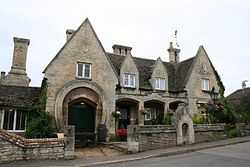Tinwell
| Tinwell | |
 Tinwell Forge |
|
 Tinwell |
|
| Area | 2.67 sq mi (6.9 km2) [1] |
|---|---|
| Population | 209 2001 Census[2] |
| – density | 78/sq mi (30/km2) |
| OS grid reference | SK993081 |
| – London | 82 miles (132 km) SSE |
| Unitary authority | Rutland |
| Shire county | Rutland |
| Ceremonial county | Rutland |
| Region | East Midlands |
| Country | England |
| Sovereign state | United Kingdom |
| Post town | STAMFORD |
| Postcode district | PE9 |
| Dialling code | 01780 |
| Police | Leicestershire |
| Fire | Leicestershire |
| Ambulance | East Midlands |
| EU Parliament | East Midlands |
| UK Parliament | Rutland and Melton |
Coordinates: 52°39′43″N 0°31′59″W / 52.662°N 0.533°W
Tinwell is a village and civil parish in the county of Rutland in the East Midlands of England.
Village
The village is just west of the A1 and within walking distance of the town of Stamford in Lincolnshire. The village has a well-used village hall, which provides a venue for parties and community events as well as regular special interest classes. Next door to the village hall is a football pitch which as well as providing a sports area is the venue for village parties. A recent major event on the field was the Queen's Diamond Jubilee in 2012 where hundreds of villagers and friends turned out for a sports day, barbeque and concert and the lighting of the jubilee beacon made at Tinwell Forge. Also nearby on Crown Lane is the village pub "The Crown" which is currently closed but has plans for refurbishment.
Tinwell has a beautiful church - All Saints' Church. The church has a distinctive tower with an unusual saddleback roof; these are rare in England and was added in about 1350. Opposite the church is The Old Rectory, birthplace of Thomas Laxton (1830-1893) who conducted plant-breeding research for Charles Darwin and developed the Laxton Superb and Laxton Fortune apples and the Royal Sovereign strawberry.
Other buildings of interest are Tinwell Forge and Bakery which are located on Main Street and were built in 1848. At the front of the forge is a stone surround to the village spring, which was built for the Golden Jubilee of Queen Victoria; there is also a Victorian post box.The bakery closed in 1948 but the forge continues to be in operation. By the riverside is Tinwell Mill, although it is now a private house a mill stood at the same site during the Domesday period.
Walks can be taken from Tinwell south towards Easton on the Hill, with its Norman church and the Priest's House; west around the limestone quarry and along the rivers Chater and Welland towards Ketton, Aldgate and Geeston; and east following the Jurassic Way towards Stamford, and the Macmillan and Hereward Ways to Wothorpe and Burghley House. There is a footpath map showing these routes in the churchyard.
World War II
On 8 July 1944, two C47s collided after taking-off from RAF Spanhoe for an exercise. One crew member managed to parachute safely but eight others and 26 Polish paratroops of the Polish 1st Independent Parachute Brigade perished in the crash. The American casualties from 315th Troop Carrier Group were taken to the Cambridge American Cemetery for burial and the Polish casualties were taken to the Polish Cemetery at Newark. All those killed are commemorated in the church.
Ingthorpe
The village is associated with the site of the lost or shrunken medieval village of Ingthorpe,[3] in the north of the parish, close to the River Gwash.
References
- ↑ "A vision of Britain through time". University of Portsmouth. Retrieved 21 March 2009.
- ↑ "Rutland Civil Parish Populations" (PDF). Rutland County Council. 2001. Retrieved 21 March 2009.
- ↑ "Pastscape". Ingthorpe. English Heritage. 2007. Retrieved 10 April 2010.
External links
![]() Media related to Tinwell at Wikimedia Commons
Media related to Tinwell at Wikimedia Commons